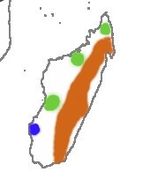- Mesite
-
Mesites 
Subdesert Mesite. Scientific classification Kingdom: Animalia Phylum: Chordata Class: Aves Order: Mesitornithiformes (but see article) Family: Mesitornithidae
Wetmore, 1960Genera Mesitornis
Monias
Respective ranges: Brown Mesite in orange, White-breasted Mesite in green and Subdesert Mesite in blue The mesites (Mesitornithidae) are a family of birds of uncertain affinities. They are smallish, near flightless birds endemic to Madagascar. Generally brownish with paler undersides, they are of somewhat pheasant-like appearance and were initially placed with the Galliformes. Most commonly, they are placed in the Gruiformes (cranes, rails and allies), but this has been disputed in more recent times. They are the only family with more than two species in which every species is threatened; all three are listed as vulnerable and are expected to decline greatly in the next 20 years.[verification needed]
Contents
Biology
They are forest and scrub birds which feed on insects and seeds. The Brown and White-breasted Mesites forage on the ground, gleaning insects from the leaves and under them, as well as low vegetation. The Subdesert Mesite uses its long bill to probe in the soil. Other birds, such as drongos and flycatchers[disambiguation needed
 ], will follow mesites to catch any insects they flush and miss. Mesites are vocal birds, with calls similar to passerine song, used for territorial defence. Two or three white eggs are laid in a stick-nest located in a bush or low branch.[1] The Mesitornis species are monogamous; Monias benschi is polygamous and unlike the other two shows significant sexual dichromatism.
], will follow mesites to catch any insects they flush and miss. Mesites are vocal birds, with calls similar to passerine song, used for territorial defence. Two or three white eggs are laid in a stick-nest located in a bush or low branch.[1] The Mesitornis species are monogamous; Monias benschi is polygamous and unlike the other two shows significant sexual dichromatism.Taxonomy
Historically, mesites have been allied with the doves and the dippers. While the latter is certainly incorrect, there is some indication that they might indeed be closer (though not very close) to the Columbiformes.[2] The purported gruiforms Kagu and Sunbittern (and possibly the extinct adzebills too) might also be not-too-distant relatives. These latter taxa, remarkably, were all only tentatively placed in the Gruiformes, and are apparently all of Gondwanan origin; like the mesites, the Kagu and Sunbittern are among the rather few birds possessing powder down. Still, the data hinting at a possible relationship between the "odd gruiforms" (and possibly pigeons) is by no means robust enough to draw a firm conclusion. (Fain & Houde 2004) Arguably, they might be considered an order of their own (Mesitornithiformes) as has on occasion been done in the past, but unlike with the Hoatzin, little phylogenetic research has yet been conducted on mesites.
The DNA study of Hackett et al.[2] confirms that the Mesites are a sister group of the doves, somewhat more distantly related to the sandgrouse, tropicbirds, grebes, and flamingos.
Systematics
There are two genera, Mesitornis (2 species) and Monias (Subdesert Mesite).
- White-breasted Mesite, Mesitornis variegata
- Brown Mesite, Mesitornis unicolor
- Subdesert Mesite Monias benschi
References
- Fain, Matthew G. & Houde, Peter (2004): Parallel radiations in the primary clades of birds. Evolution 58(11): 2558-2573. doi:10.1554/04-235 PMID 15612298 PDF fulltext
External links
- Subdesert Mesite (Ifaty, Madagascar) — a photo by Luke W. Cole
- Mesite videos on the Internet Bird Collection
Categories:- Mesitornithidae
- Higher-level bird taxa restricted to the Malagasy region
Wikimedia Foundation. 2010.
